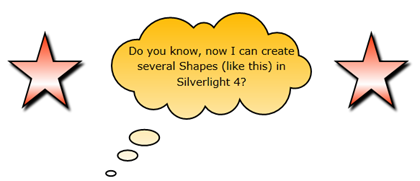In my previous post “Introduction to Shapes in Silverlight 4” I introduced you with various types of Shapes available in Silverlight 4 and informed you that, I will post an article describing each one of them and here it is.
In this article, I am going to describe you about each shapes and the process to add them in our application (whenever you need). This article is for the Beginners, who don’t know much about the shape controls. If you have any suggestions/concerns please use the feedback section to let me know.

 First of all, a Big Thanks to all my readers who continuously supported me during last six months by voting my articles in CodeProject. I also appreciate you for your regular feedbacks and suggestions to improve. I tried my level best to answer your queries in each article’s page.
First of all, a Big Thanks to all my readers who continuously supported me during last six months by voting my articles in CodeProject. I also appreciate you for your regular feedbacks and suggestions to improve. I tried my level best to answer your queries in each article’s page.
